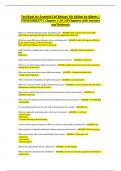Summary
Animals evolution and adaptation summary (NWI-BP004C)
- Course
- Institution
The document is about the evolution of animals. Where all multicellular organisms started and how they developed into extraordinary creatures. 3 super phyla and 14 phylum are being discussed. The body plan and the characteristics are explained. The document also contains the comparisons in vertebra...
[Show more]












